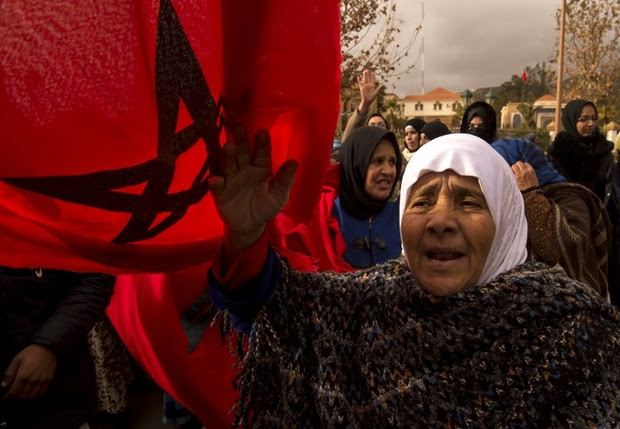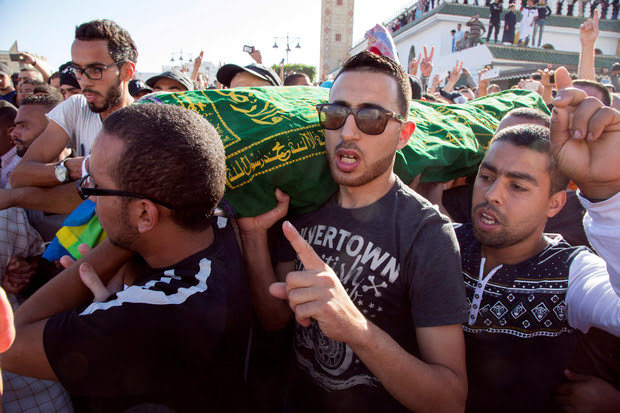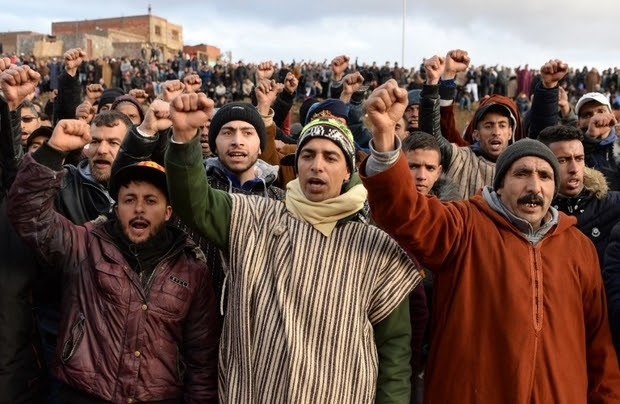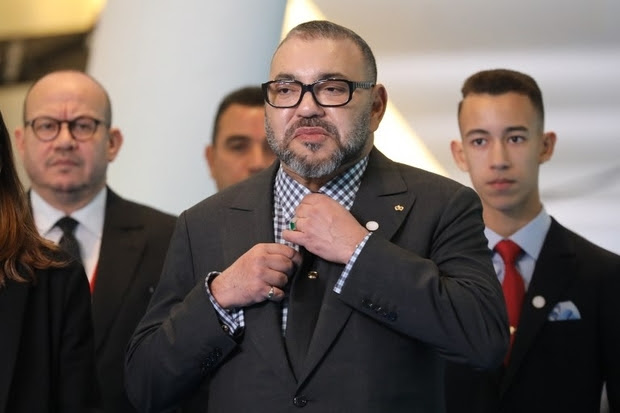Middle East Eye
On 29 July, Morocco’s King Mohammed VI called on the government to take “emergency measures” in order to address the country’s social and economic problems.
“I invite the government and all relevant actors to undertake a comprehensive and deep restructuring of national social protection and support programmes and policies and to submit proposals for their evaluation modalities,” King Mohammed said. “We continue to be lacking something in social matters,” he added, pointing to social support and social protection programmes that “overlap each other, suffer from a lack of consistency and fail to effectively target eligible groups.”
But did the King of Morocco believe that it was possible to “change without changing”?
When one looks back at the path the country has followed since 2011, it is tempting to say that for the palace, it was simply a question of “reproducing the previous system in a new institutional form”, to use the phrase of political scientist Lahouari Addi on Algeria.
Confronted by citizens who are asking their state to reinvent itself and shape a new horizon for them, Morocco is offering old wine in new bottles.
A wave of arrests
The king’s speech, delievered in the Rif region in the city of Al Hoceima where popular protests over poverty and neglect erupted in 2016, came almost a month after 53 Rif activists, including the Hirak’s protest leader, Nasser Zefzafi, were sentenced to up to 20 years in jail on charges of undermining state security and attacking law enforcement members.
The Hirak movement was born in October 2016 following the death of street vendor, Mouhcine Fikri, who was crushed in a dumpster while trying to recover goods confiscated by the police in Al Hoceima, northern Morocco. It is considered to be a social movement that managed to continue to organise protests for nearly ten months before a wave of arrests targeted its leaders and activists.
Protesting against the “economic blockade” from which the al Hoceima region suffers, the movement’s demands centred around developmental issues; setting up factories, extension of the railway line to Al Hoceima, construction of a multidisciplinary university as well as providing equipment to Al Hoceima’s oncology centre.
The Rif has a high cancer prevalence, and the Hirak movement claims that there was an official recognition of the link between the use of mustard gas during the Rif War (1921-1926) and the high cancer mortality rate in the region.
The Hirak is a social movement that continued to organise protests for nearly ten months before a wave of arrests targeted its leaders and activists
Among the Hirak’s demands were the creation of jobs to reduce unemployment in the region, the fight against corruption, particularly in the maritime fishing sector, and the introduction of social protection systems for the fishermen.
In the history of Moroccan social movements, the Hirak is an unprecedented phenomenon: it is the first local and organised movement to have rallied so many participants and sympathisers, and to have demonstrated more or less with a regular frequency for a relatively long time.
The Hirak’s adaptability
Among the reasons behind the longevity of Hirak is its high adaptability. As the state’s repressive measures against it increased, the demonstrators adapted their strategies of occupation of public space accordingly: sit-ins and demonstrations that had been scheduled several days in advance were now replaced by “hit and run” actions, such as chen-ten and indimam (rallying). These two spontaneous forms of protest, according to researchers Hamza Essmili and Montaser Sakhi who study the Hirak, start as soon as “a core group of demonstrators chooses a place – a busy avenue, a garden or a public square – and then chant Hirak slogans”.
Mohsin Fikri funeral at al-Hocima (REUTERS)
“They were then quickly joined by other activists and sympathisers. Once the police intervene and the demonstration is dispersed, another core of activists takes over, and relaunches the protest in another place of the city,” Essmili and Sakhi wrote in a series of remarks on the Hirak.
The readjustments of the Hirak made it possible to ensure the survival of the movement on the short term, but were not without a price. As the movement expanded, growing fears that the movement might be hijacked from within forced its leaders to abandon certain forms of deliberation inherited from the February 20 Movement, which led a wave of protests in Morocco in the wake of the Arab Spring in 2011 calling for social demands.
The Hirak was also a source of emulation. Organised under the banner of local Hiraks, residents of the cities of Zagora (in the south), and Jerada (in the east) demonstrated for several weeks for their local demands.
A ‘secessionist’ movement?
From October 2016 to May 2017, when the Hirak demonstrations were almost systematically blocked and its leaders arrested, the palace remained passive. Even as the movement increasingly challenged the king directly, the monarch chose to remain silent. Negotiations and mediation attempts were conducted by local government officials and politicians, but were unsuccessful.
Not only did they not offer satisfactory reponses to some of the movement’s demands, but they were also perceived as being part of a modus operandi aimed at defusing social movements.
The mediation venues, conceived by the authorities as a way of demobilising and neutralising the protests, would have weakened the Hirak, just as a clientele-oriented strategy of dividing militant groups had defused the 2008 Sidi Ifni protests in southern Morocco.
At the same time, the Moroccan authorities and official media led a campaign aimed at discrediting the Hirak, framing it as a “secessionist” movement that threatens to destabilise the country.
Residents of Jerada protest for an economic alternative to the “the mines of death” (AFP)
The accusation of secessionism is linked to the display of flags of the Rif Republic, an ephemeral republic established by Abdelkrim El Khattabi between 1921 and 1927, as well as to the identity-inspired rhetoric of the Hirak leaders.
The use of an identity-centred rhetoric by some Hirak leaders, according to Hirak activists, is part of a “conversion of the identity into a resource”, made possible by the very strong regional identity of the Rif and its history: the repression suffered by the region between 1958 and 1959 and in 1984 should, according to Hirak leaders, motivate the state to devote more efforts to the region.
The Arab Spring parenthesis
The repression of the Hirak and the sentencing of its leaders to heavy imprisonment have shattered the hopes for democratisation of the country, as expressed by the Moroccan street in 2011. Between 2016 and 2018, the little progress made in 2011 evaporated, and the political process that was initiated following the Arab Spring was aborted after the 2016 legislative elections.
Following the protests led by the 20 February Movement during the Arab Spring, the monarchy was able to capture the demands of the street and integrate them into its own agenda. The king proceeded to a constitutional revision, which in principle gave the prime minister greater powers. On 25 November 2011, early legislative elections were held, following which the Justice and Development Party (PJD) came first, and its secretary-general, Abdelilah Benkirane, was appointed prime minister.
READ MORE ►
Is Morocco’s boycott the future of political resistance in North Africa
The peaceful cohabitation between the palace and the PJD lasted as long as the party did not rebel against the political system and its tacit rules – the interventionism of the monarchy in the political game – nor sought to modify the balance of power in its favour. For the monarchy, at first, the experience seems to have been thought of as a “parenthesis”, with the wear and tear of power inevitably belittling Benkirane’s popularity.
For the king, it was a matter of strengthening and re-legitimising his place as the arbiter above the institutions, in charge of supervising the democratisation of the country. He thus offered himself the opportunity, at little cost, to play a role of the “critical spectator” of political life who lectures about the shortcomings and fulminates against the gaps. In parallel, Mohammed VI developed a discourse serving this new positioning “alongside the people”, and critical towards the political field.
In fact, for lack of having been really implemented, “democratisation” constituted a “new political opportunity, the new language but also the new place of political confrontation”, and “all political currents seized the opportunity that was ‘democracy’ not to debate ideas and visions, not to assert new principles of action and new modes of government, but to defend interests and to place themselves as well as possible within the State. Democracy has been the language of repositioning,” in the words of political scientists Beatrice Hibou and Hamza Meddeb.
Moroccan King Mohammed VI (AFP)
By removing the partisan nature of the economic issues, the monarchy has reinforced the concept that “economic choices are not civic choices but technical choices. One could, therefore, say that the economy is no longer political and that politics is no longer confrontational,” analyses political scientist Jean-Noël Ferrié.
Unpopular reforms
That Benkirane agreed to carry out unpopular economic reforms during his mandate is not accidental. Although he said he was convinced of their “urgency” and “necessity”, he nevertheless agreed to assume a role that was prescribed to him by the Moroccan political elite and that would, sooner or later, affect his popularity.
For the monarchy, allowing the parties that once belonged to the opposition camp access to the government implies that in return, the parties will be co-managing the social and political crises. “As a result of their inclusion, the government will be able to extract valuable resources for its authoritarian consolidation of power,” as Abderrahim El Maslouhi noted. In exchange, the former opposition enjoys “authorised access to institutional resources”.
For international donors (IMF, World Bank), the presence of a representative government is viewed as an opportunity: the government could finally carry out the reforms they recommend. The political cost of these reforms requires an executive with a strong popular base to undertake them.
Due to the absence of debate on the content of these reforms, however, they are now strongly contested.
It was precisely the consequences of these reforms, carried out without consultation, that led to Benkirane being ousted by the monarch.
As soon as the boycott movement broke out, a parliamentary report highlighted the significant gains made by Moroccan oil companies by overcharging for fuel – 13bn dirhams (€1.1bn) according to TelQuel magazine, 17bn dirhams (€1.5bn) according to MP Omar Balafrej, affiliated to the Federation of the Democratic Left (FGD). This served as a reminder to Moroccan public opinion that it was Benkirane who initiated the liberalisation of fuel prices.
The disregard for the vote, the transformation of “democratisation” into a lexicon of political repositioning rather than a collective endgame, the depoliticisation of economic and social issues and the repression of social protest will all work in tandem and lead to the current situation.
READ MORE ►
Social protest in Morocco: Does Mohammed VI have a plan?
Their effects are damaging to say the least: disaffection with the established policy and multiplication of social movements, loss of confidence in representative institutions and, more broadly, in the state and its symbols.
Moroccan citizens are questioning as much the failed democratic process as the growing inequality gap, the inefficiency of political institutions, and the prevailing repressive approach.
More and more, “things are called by their name”. In other words, the causes are publicised, the economic and political issues linked to each other, and the official rhetoric that protects the king from being reprimanded and avoids his share of responsibility is stripped away. But will Mohammed VI learn from the current situation?
– Reda Zaireg is a Moroccan freelance journalist. He has worked for the Moroccan magazine TelQuel, the online newspaper Medias24.com, and the Huffington Post Maroc.
The views expressed in this article are the author’s own and do not necessarily reflect the editorial policy of Middle East Eye.
Photo: A protest after the funeral of two brothers who died while digging in an abandoned coal mine in the northeastern town of Jerada, 60 kilometers southwest of Oujda, Morocco on 27 December, 2017 (AFP).











